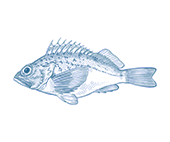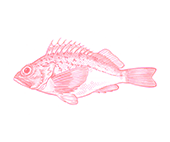




- Say No
Wild Caught
Region:
TAS
- Southern Calamari are a fast growing, short-lived (around 12 months) species that reproduces quickly and produces a high number of offspring; though the success of reproduction is affected by environmental conditions.
- Southern calamari is primarily caught using Squid jig, but also purse seine, beach seine, spear and dipnet fishing methods in Tasmania.
- The fishery has been subject to severe overfishing in recent years and localised depletion has been detected in key areas
- The jig fishing method used to catch most squid in Tasmania have minimal impacts on marine habitats or other species.
- TAS Scalefish Fishery (107t in 2018/19, 61t in 2017/18)
Southern calamari is a fast growing, short-lived (around 12 months) species that reproduces quickly and produces a high number of offspring. This makes them highly resilient to fishing pressure. Undertaking formal stock assessments (scientific assessments of the numbers of a species) of squid species is generally difficult for fishery managers, as reproduction is highly variable depending on environmental conditions.
The last AMCS assessment, conducted in 2018, awarded the fishery a green ranking on the basis that the most recent stock assessment did not identify increasing fishing effort as a problem, and that proactive management measures were in place. However, it has become clear that these measures have failed to adequately contain fishing levels in recent years and severe overfishing has been occuring.
A recent government scientific assessment found that catches of more that 100t in recent years exceeded recent estimates of the state-wide maximum sustainable yield by more than 40%. Concerns were also raised about catches in the north coast region exceeding sustainable yields by more than 100%.
Localised depletion has been detected as effort has shifted to Northern Tasmania in recent years. Despite management implementing seasonal spatial closures aimed at protecting spawning aggregations (when species are gathered together for breeding), these do not (yet) appear to have been effective in protecting biomass.
The assessment may require revision in the future when a pandemic-delayed stock assessment becomes available.
Squid are an important predator whose exploitation could negatively affect the ecosystem and community structure. Given that total catches of southern calamari have risen since 2012/13, and that the effort has shifted to the north coast, it is likely the overall environmental risk has increased. This needs to be better understood in the Tasmanian fishing grounds where squid are targeted.
There has been investment by managers in understanding climate change impacts on key Scalefish Fishery species, which is welcome. But there do not yet appear to be strategies for managing fishing impacts in Tasmania’s rapidly changing ocean climate.
Most southern calamari are caught in Tasmania using jig fishing methods, which do not impact seafloor habitats and have little or no catch of any other species.


